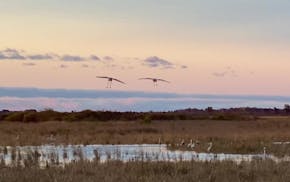At this stage of winter, you might be weary of our naked landscape. But if you look around, you'll notice the unsung heroes of the season: evergreens.
Because most deciduous trees and shrubs go leafless from November through April, evergreens are essential to northern landscapes, where green foliage of any kind is a blessing in our long winters.
Simply put, an evergreen is a plant that retains living foliage throughout the year. Evergreens can be broad-leafed or narrow-leafed (needled), but in Minnesota, we rely almost exclusively on the needled evergreens such as pine and spruce. (A few broad-leafed evergreens, such as PJM rhododendron and Korean littleleaf boxwood, survive here, but these shrubs don't have as much impact on the landscape as the larger evergreens.)
Evergreens not only retain their good looks through winter, but also serve a practical role by blocking winter winds and providing year-round screening. Dense evergreens give birds protection from wind and serve as a refuge during snowstorms, as well.
From a design perspective, evergreens add structure and mass to a landscape. When carefully placed, they help move the viewer's eye through the landscape toward a focal point. That's an especially important quality when deciduous trees are in their "see-through" state.
Here's a gallery of the best evergreens for our area.
Pine
(Pinus)
Although they often have a conical shape when young, pines tend to develop a more open, wide-spreading form as they age. And mature pines make wonderful winter accents -- from the majestic, horizontally layered branches of white pine (Pinus strobus), left, to the picturesque form and cinnamon-orange bark of Scots pine (P. sylvestris).
Other good choices include red or Norway pine (P. resinosa) and Ponderosa pine (P. ponderosa) as well as the handsome but less well-known Korean pine (P. koraiensis) and Swiss stone pine (P. cembra).
SPRUCE
(Picea)
Because they retain a dense, conical form throughout their lives, spruces are one of the best choices for windbreaks and screening. Spruces have short (less than an inch) single needles with sharp tips.
White spruce (P. glauca) and Black Hills spruce (P. glauca var. densata), a variety with denser growth and darker green foliage, are very hardy and tolerate a range of soil types. Norway spruce (P. abies) has distinctively drooping branchlets and large, pendant cones. Colorado spruce (P. pungens), right, especially blue-foliaged selections, is striking, but can be disease-prone, especially in wet or humid sites.
FIR
(Abies)
These particularly lovely evergreens have an upright, conical form like the spruce, but with a more graceful, less stiff demeanor. But firs are a little fussy. They generally prefer cool growing conditions with plenty of soil moisture and are intolerant of hot, dry sites.
The best known fir in northern regions is the native balsam fir (A. balsamea), right, beloved for its fragrant, deep-green needles and often grown for use as Christmas trees. But white fir (A. concolor) is probably the best choice for city landscapes because it tolerates urban conditions better than balsam fir does.
Canadian hemlock
(Tsuga canadensis)
Canadian hemlock forms a graceful pyramidal tree, which grows 30 to 50 feet tall in most landscape settings. Although it still needs sun for best growth, it's one of the most shade-tolerant needled evergreens. Canadian hemlock makes a wonderful single specimen and looks great in group plantings or as a hedge, but it needs adequate soil moisture and protection from dry winter winds.
Arborvitae
(Thuja occidentalis)
Also known as white cedar, arborvitae is a very popular choice for northern yards. This native evergreen usually has an upright, columnar to pyramidal form, but many cultivars offer globe, spire or dwarf pyramidal forms.
Arborvitae often is planted in groups or as a hedge, sheared or unsheared. Its mature foliage consists of small, dark green scales tightly pressed to the branchlets, which looks quite different from needled evergreens.
Juniper
(Juniperus)
There are many species and cultivars of junipers, ranging from large trees such as eastern red cedar (J. virginiana), above, to ground-cover creepers. And the foliage is just as varied, ranging from bright green to gray-green to silvery blue.
Junipers grow best in full sun, but can tolerate average soil conditions. They're best when planted in small groups or as hedges.
Nancy Rose is a horticulturist with the University of Minnesota Extension. To ask her a gardening question, call 612-673-9073 and leave a message. She will answer questions in this column only.
Sign up for Star Tribune newsletters

Sandhill cranes coming to roost
Oscar-winning actor Maggie Smith dies at 89

